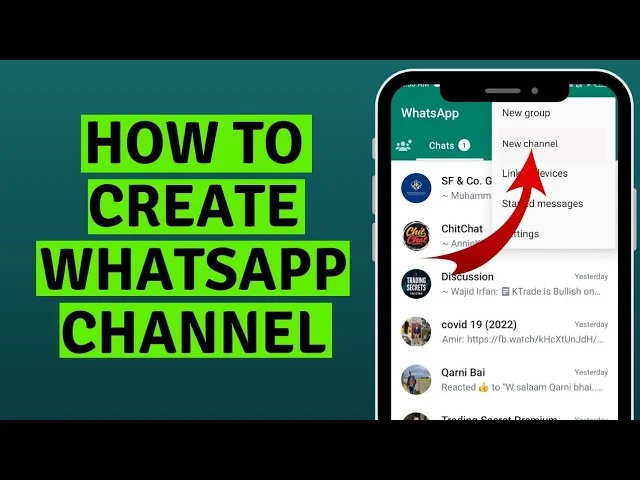Creating a WhatsApp Channel: A Comprehensive Guide
Creating a WhatsApp Channel: A Comprehensive Guide

In a world dominated by instant messaging apps, WhatsApp reigns supreme. With over 2 billion users globally, it's no wonder that businesses and individuals alike are eager to tap into its potential. WhatsApp channels have emerged as a powerful tool for communication, marketing, and customer service. If you're looking to create your own WhatsApp channel, this comprehensive guide will walk you through the process step by step.
Table of Contents
Introduction
- Understanding WhatsApp Channels
- Why Create a WhatsApp Channel?
- Prerequisites
Setting Up Your WhatsApp Business Account
- Downloading WhatsApp Business App
- Verifying Your Phone Number
- Configuring Business Profile
Creating a WhatsApp Channel
- Different Types of WhatsApp Channels
- Choosing a Channel Type
- Registering Your WhatsApp Channel
Building Your WhatsApp Channel
- Adding Contacts
- Personalizing Your Channel
- Setting Up Automation
Content Strategy
- Crafting Engaging Content
- Planning Your Content Calendar
- Best Practices for Content Delivery
Promoting Your WhatsApp Channel
- Leveraging Other Marketing Channels
- Social Media Integration
- Growing Your Subscriber Base
Managing and Analyzing Your Channel
- Handling Subscribers
- Monitoring Channel Performance
- Using Analytics Tools
Legal and Privacy Considerations
- WhatsApp Business Policy Compliance
- Data Privacy and Consent
- Handling Customer Data Securely
Customer Service and Support
- Providing Timely Responses
- Handling Queries and Complaints
- Building Customer Loyalty
Advanced Strategies
- Implementing Chatbots
- Integrating WhatsApp with CRM
- Multi-language Support
Case Studies
- Success Stories
- Lessons Learned
Troubleshooting Common Issues
- Delivery Problems
- Technical Glitches
- Spam Reports
Future Trends and Innovations
- WhatsApp Updates and Features
- Predictions for WhatsApp Channels
Conclusion
- Recap of Key Takeaways
- Your Journey Ahead
1. Introduction
Understanding WhatsApp Channels
WhatsApp channels are a communication method on WhatsApp Business that allows businesses, organizations, and individuals to interact with their customers or followers. They provide a direct line of communication, making it easier to send updates, notifications, promotional content, and provide customer support.
Why Create a WhatsApp Channel?
There are numerous reasons to create a WhatsApp channel, including:
Direct Communication: Reach your audience directly without the noise of social media algorithms or email spam folders.
Customer Engagement: Engage your audience with rich media, such as images, videos, and links, fostering deeper connections.
Customer Support: Provide real-time customer support, answer queries, and resolve issues efficiently.
Marketing: Use WhatsApp channels for marketing campaigns, promotions, and product launches.
Automation: Automate responses and workflows to save time and provide 24/7 availability.
Prerequisites
Before you dive into creating your WhatsApp channel, ensure you have the following:
- A smartphone with an active phone number (not necessarily your personal number).
- A stable internet connection.
- A business or organizational profile (if applicable).
2. Setting Up Your WhatsApp Business Account
Downloading WhatsApp Business App
Start by downloading the WhatsApp Business app from your device's app store. It's a separate app from the regular WhatsApp and is designed specifically for businesses.
Verifying Your Phone Number
After installing the app, verify your phone number. You can use either your personal or dedicated business number. WhatsApp will send a verification code to that number.
Configuring Business Profile
Create a business profile for your WhatsApp channel. This includes adding your business name, logo, and a brief description. A complete and professional profile is crucial for building trust with your audience.
3. Creating a WhatsApp Channel
Different Types of WhatsApp Channels
WhatsApp offers different types of channels, including:
- One-Way Broadcast Channel: Businesses can send messages to customers, but customers can't reply. Ideal for broadcasting updates.
- Two-Way Communication Channel: Allows customers to reply to messages. Great for customer service and engagement.
- Template Message Channel: Use pre-approved templates for specific use cases, like appointment reminders or order updates.
Choosing a Channel Type
Consider your goals and audience when choosing a channel type. For most businesses, a two-way communication channel is recommended for better engagement and customer interaction.
Registering Your WhatsApp Channel
To create a WhatsApp channel, you need to apply through the WhatsApp Business API or contact a WhatsApp Business Solution Provider (BSP) for assistance. This step requires approval, and WhatsApp may have specific requirements.
4. Building Your WhatsApp Channel
Adding Contacts
Start by adding contacts to your WhatsApp channel. You can manually add them or provide an opt-in option on your website or social media.
Personalizing Your Channel
Customize your WhatsApp channel with a unique name, profile picture, and description that reflects your brand identity.
Setting Up Automation
Utilize automation tools to schedule messages, set up welcome messages, and create auto-responses to common queries. This ensures a seamless customer experience.
5. Content Strategy
Crafting Engaging Content
Create content that resonates with your audience. Use a mix of text, images, videos, and links to keep your messages interesting and valuable.
Planning Your Content Calendar
Develop a content calendar to ensure a consistent flow of messages. Consider holidays, events, and promotions when scheduling content.
Best Practices for Content Delivery
Follow best practices such as sending messages at appropriate times, avoiding spammy content, and respecting user preferences.
6. Promoting Your WhatsApp Channel
Leveraging Other Marketing Channels
Cross-promote your WhatsApp channel on your website, social media profiles, email newsletters, and other marketing materials.
Social Media Integration
Integrate WhatsApp with your social media profiles for seamless sharing and interaction.
Growing Your Subscriber Base
Implement strategies like running WhatsApp contests, offering exclusive content, and using call-to-action buttons to encourage more users to join your channel.
7. Managing and Analyzing Your Channel
Handling Subscribers
Maintain a clean subscriber list by removing inactive or unsubscribed users. Address user queries and concerns promptly.
Monitoring Channel Performance
Track metrics like message open rates, click-through rates, and response times to gauge the success of your channel.
Using Analytics Tools
Consider using third-party analytics tools to gain deeper insights into user behavior and preferences.
8. Legal and Privacy Considerations
WhatsApp Business Policy Compliance
Adhere to WhatsApp's policies to avoid being banned or restricted. Stay updated on policy changes.
Data Privacy and Consent
Respect user privacy and obtain consent before sending messages. Implement data protection measures to secure user information.
Handling Customer Data Securely
Store and handle customer data securely to comply with data protection regulations.
9. Customer Service and Support
Providing Timely Responses
Offer quick and helpful responses to user queries. Implement chatbots to handle common inquiries.
Handling Queries and Complaints
Address customer complaints and concerns professionally and promptly.
Building Customer Loyalty
Build trust and loyalty by providing exceptional customer service and personalized experiences.
10. Advanced Strategies
Implementing Chatbots
Explore the use of AI-powered chatbots to automate customer interactions and improve efficiency.
Integrating WhatsApp with CRM
Integrate WhatsApp with your Customer Relationship Management (CRM) system for a seamless customer experience.
Multi-language Support
If your audience is diverse, consider offering multi-language support to cater to different language preferences.
11. Case Studies
Learn from successful WhatsApp channel case studies to understand what works and what doesn't.
Success Stories
Explore how businesses in various industries have leveraged WhatsApp channels to achieve their goals.
Lessons Learned
Identify common pitfalls and learn from the mistakes of others to optimize your own channel.
12. Troubleshooting Common Issues
Delivery Problems
Troubleshoot common issues like message delivery failures and slow response times.
Technical Glitches
Address technical glitches that may arise and find solutions to keep your channel running smoothly.
Spam Reports
Handle spam reports professionally and take steps to prevent them.
13. Future Trends and Innovations
Stay ahead of the curve by exploring upcoming WhatsApp updates and features.
WhatsApp Updates and Features
Discover the latest features and updates that can enhance your WhatsApp channel's performance.
Predictions for WhatsApp Channels
Explore industry experts' predictions on the future of WhatsApp channels and how they will evolve.
14. Conclusion
Recap of Key Takeaways
Summarize the key points from each section to reinforce the knowledge gained.
Your Journey Ahead
Encourage readers to take action and start creating their own WhatsApp channel, emphasizing the potential benefits and the importance of staying updated with WhatsApp's policies and features.
By following this comprehensive guide, you'll be well-equipped to create and manage a successful WhatsApp channel that connects with your audience, enhances your business, and provides exceptional customer experiences.

Post a Comment